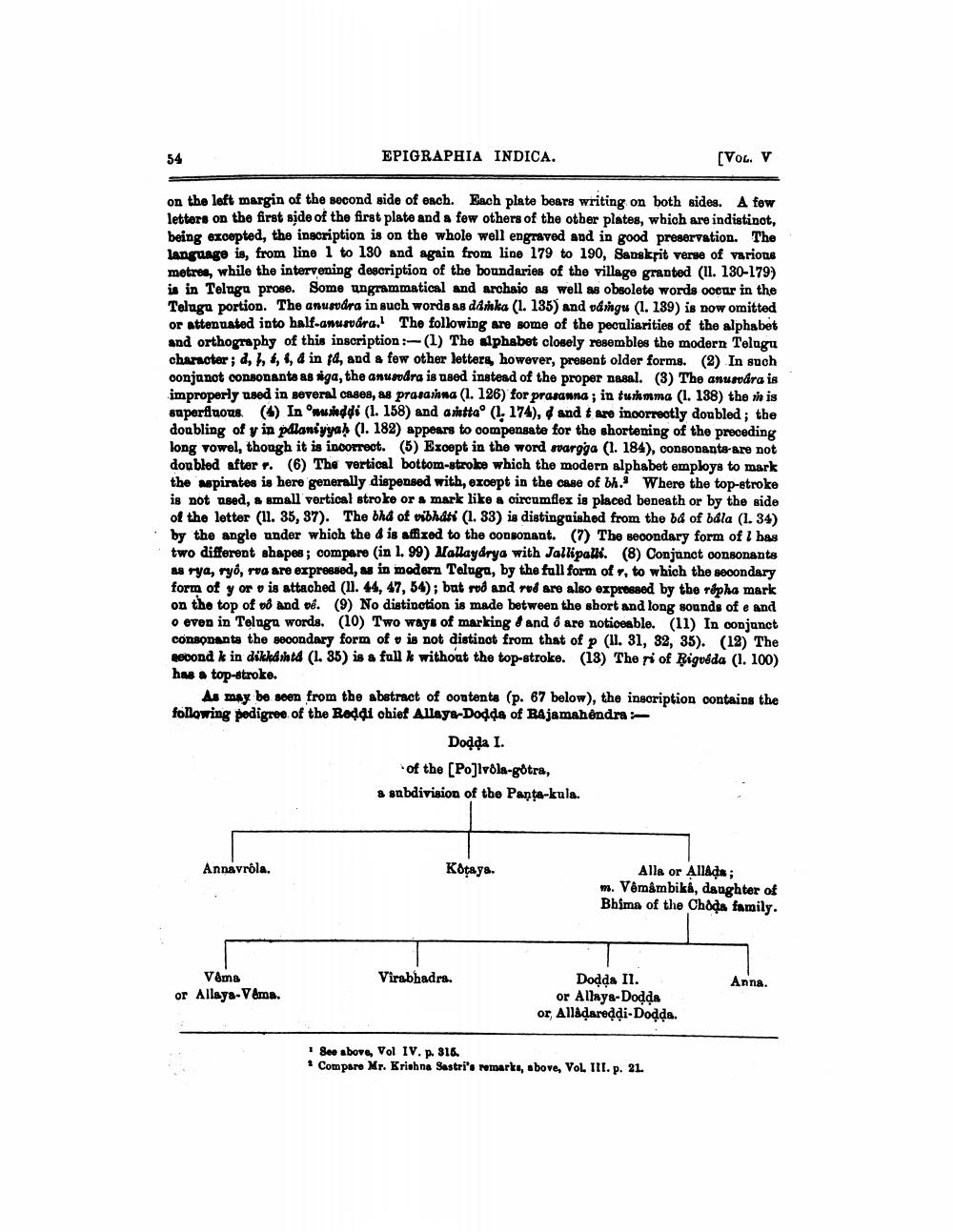________________
54
EPIGRAPHIA INDICA.
[VOL. V
on the left margin of the second side of each. Each plate bears writing on both sides. A fow letters on the first side of the first plate and a few others of the other plates, which are indistinot, being excepted, the inscription is on the whole well engraved and in good preservation. The language is, from line 1 to 130 and again from line 179 to 190, Sanskrit verse of various metree, while the intervening description of the boundaries of the village granted (11. 130-179) is in Telugu prose. Some ungrammatical and archaio as well as obsolete words oocar in the Teluga portion. The anus dra in such words as dánka (1. 135) and vdingu (1. 139) is now omitted or attenuated into half-anusuára. The following are some of the peculiarities of the alphabet and orthography of this inscription :-(1) The slphabet closely resembles the modern Telugu character; d, b, 4, 1, & in fd, and a few other letters, however, present older forms. (2) In such oonjunot consonants as nga, the anus dra is used instead of the proper nasal. (3) The anusára is improperly used in several cases, as prasasina (1. 126) for prasanna ; in turmma (1. 138) the nn is superfinous (6) In winddi (1. 158) and anttao (1174), and t are incorrectly doubled; the doubling of y in pllaniyyah (1. 182) appears to compensate for the shortening of the preceding long vowel, though it is incorrect. (5) Except in the word svargga (1. 184), consonants are not don bled after . (6) The vertical bottom-stroke which the modern alphabet employs to mark the mpirates is here generally dispensed with, except in the case of bh. Where the top-stroke is not used, a small vertical stroke or a mark like a circumflex is placed beneath or by the side of the letter (11. 35, 37). The bhd of vibháti (1. 33) is distinguished from the bů of bala (1. 34) by the angle ander which the d is affixed to the consonant. (7) The secondary form of l bas two different shapes; compare (in 1. 99) Mallaydrya with Jallipalk. (8) Conjunct consonants as rya, ryô, roa are expressed, as in modern Teluga, by the full form of, to which the secondary form of y or v is attached (11. 44, 47, 54); bat rod and rod are also expressed by the répha mark on the top of að and vê. (9) No distinction is made between the short and long sounds of e and o even in Telaga words. (10) Two ways of marking & and 8 are noticeable. (11) In conjunct consonants the secondary form of is not distinct from that of p (II. 31, 32, 35). (12) The abond k in dikkedshta (1. 35) is a full k withoat the top-stroke. (13) The ri of Rigveda (I. 100) has a top-stroke.
As may be seen from the abstract of contents (p. 67 below), the inscription contains the following pedigree of the Reddi chief Allaye-Dodds of Rajamahendra -
Dodda I. of the [PO]lvola-gotra, a subdivision of the Panţa-kula.
Annavrôla.
Kotays.
Alla or Allada; m. Vėmâmbika, danghter of Bhima of the Choda family.
Virabhadra.
Anna
V&ma or Allaya-Vema.
Dodds II. or Allaya-Dodda or, Alladareddi-Dodda.
See above, Vol IV. p. 316 Compare Mr. Krishna Sastri's remarks, above, VOL III. p. 2L




